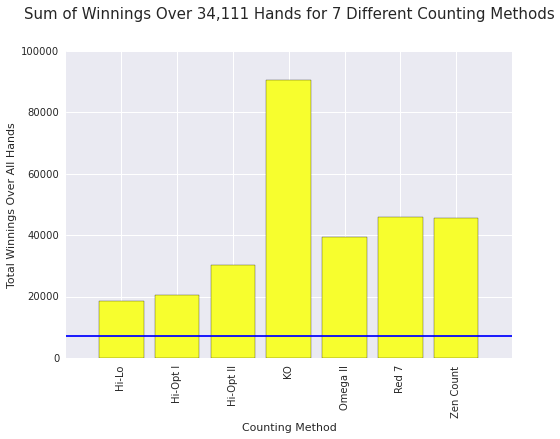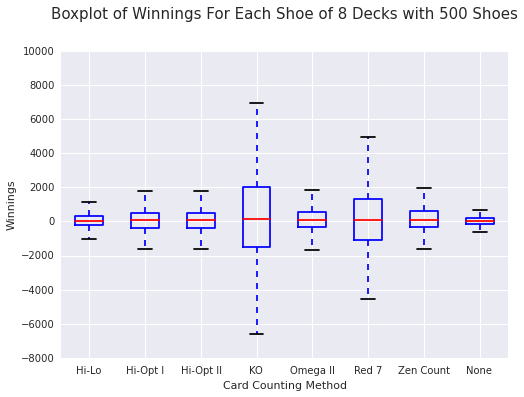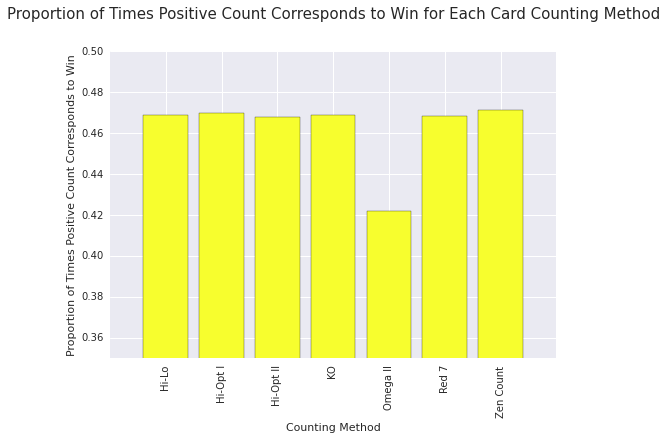Card Counting
Card counting is not magic--even though Hollywood would make it seem that way. Card counting is simply a way to have a better understanding of the cards left in the deck during play. Many moves in basic blackjack strategy rely upon the unknown card being the most common card: a 10 (as in a 10, J, Q, or a K). For example, 3, 4, 5 and 6 are often considered bust cards: when the dealer is showing a bust card, he is most likely to turn over a ten, and then hit with another ten and bust. While this does not always happen, the high occurences of tens in the deck makes it more common, than say, the dealer revealing a 5 and then hitting another 5.
Card counting is a way to take advantage of the imbalance of high cards to low cards in the shoe. When there are many high cards left in the shoe, the assumptions behind the strategy happen more often, making the game more favorable for the player. When there are many low cards left in the shoe, the assumptions do not happen as often, making the game more favorable for the casino. Therefore, card counting is a way of judging the balance of high cards to low cards in a shoe.
We simulated 500 shoes of blackjack play, with each shoe consisting of 8 decks. Over the course of these 34,000 hands, the player followed the basic blackjack strategy described here and kept a running count for seven different card counting strategies. Our goal was to determine which of these systems worked best. Each system works by keeping a running tally--adding 1 for low cards, subtracting 1 for high cards, and adding 0 for neutral cards. The seven strategies are detailed below.
| Card Strategy | 2 | 3 | 4 | 5 | 6 | 7 | 8 | 9 | 10s | A |
|---|---|---|---|---|---|---|---|---|---|---|
| Hi-Lo | +1 | +1 | +1 | +1 | +1 | 0 | 0 | 0 | −1 | −1 |
| Hi-Opt I | 0 | +1 | +1 | +1 | +1 | 0 | 0 | 0 | −1 | 0 |
| Hi-Opt II | +1 | +1 | +2 | +2 | +1 | +1 | 0 | 0 | −2 | 0 |
| KO | +1 | +1 | +1 | +1 | +1 | +1 | 0 | 0 | −1 | −1 |
| Omega II | +1 | +1 | +2 | +2 | +2 | +1 | 0 | −1 | −2 | 0 |
| Red 7 | +1 | +1 | +1 | +1 | +1 | +0.5 | 0 | 0 | −1 | −1 |
| Zen Count | +1 | +1 | +2 | +2 | +2 | +1 | 0 | 0 | −2 | −1 |
Since the count is only a metric of the current shoe, it must be reset to zero at the start of every shoe. In addition, the count must be weighted throughout game play. Take, a count of +10. We know this is favorable for the player. However, if this is the count after the first hand, it is different than the count for the last hand in the shoe. This is because we can see that as we see more and more cards (as the shoe is played), we get a more accurate count. Therefore, we will weight the count according to how much of the shoe has been played. We do this by dividing by the number of remaining decks.
We will then use each of these counts to inform our betting in the following way. We have a standard bet, in this case, it is 25. When playing without a betting strategy, we bet 25 on every hand. When we are playing with a betting strategy, we bet $25 on neutral hands. When the count becomes very low, we want to bet the minimum bet (set to the minimum possible bet at the table). In this case, the minimum bet is 15. We then create a bet spread based on the count. When the weighted count reaches +2, we bet 3x our standard bet. When the weighted count reaches +3, +4, +5, +6, +7, or +8, we bet 5x, 7x, 9x, 12x, 14x, or 20x, respectively. In doing so, we are trying to put more money on the table when the odds are in our favor.
| Weighted Count | <0 | 0 | +1 | +2 | +3 | +4 | +5 | +6 | +7 | +8 |
| Bet Spread | Min. | 1x | 1x | 3x | 5x | 7x | 9x | 12x | 14x | 20x |
As shown in the following plot, when looking at the winnings over all the simulations (34,111 hands), we found that KO by far amassed the most winnings. It is important to note that all card counting methods led to more winnings than no card counting at all. Therefore, card counting is an effective strategy for increasing winnings.

Our shoe had 8 decks in it. Separating the data by shoe, we found the mean winnings per shoe to be rather similar among all methods. However, there was a large difference in the variances. KO and Red 7 had larger variances than the other methods, most likely because they are easier card counting systems to learn. Zen also had a large mean, but with a much smaller standard deviation than KO and Red 7. Hi-Lo had the smallest standard deviation among the card counting systems, however, its mean winnings per shoe was slightly lower than the other card counting systems.

Taking a look at accuracy, the following plots show that the card counting strategies all had similar accuracy in a positive count corresponding to a win and a negative count to a loss. Zen had the highest percentage of wins corresponding to positive count, and KO the lowest. Hi-Lo was the most accurate in having a negative count correspond to a loss, although all the card counting methods had extremely similar accuracy for this. Overall, in corresponding count to win or loss, Zen was most accurate, followed closely by Hi-Opt I, Hi-Opt II and Hi-Lo. KO was least accurate, along with Omega II and Red 7.



Our Suggestion for Choosing a Card Counting System
For the true gambler: KO has the potential to amass a large amount of winnings, it can also vary greatly and is less reliable than other strategies. Therefore, we recommend this strategy only to someone who is willing to go big or go home. THE KO SYSTEM
For the risk-averse gambler: Hi-Lo, Hi-Opt I and Hi-Opt II appear to be less risky strategies, with Hi-Opt II amassing the most winnings. Therefore, out of the three less risky strategies for a less risky gambler, we suggest the Hi-Opt II system. THE HI-OPT II SYSTEM
For the beginner counter: Hi-Lo is a less risky strategy and one of the simplest card counting strategies to learn. We recommend this to the beginner for its uncomplicated system and better-than-nothing payout. THE HI-LO SYSTEM
For the advanced player: Although the Zen system is a bit more complicated due to it's addition and subtraction of 2's as well as 1's, Zen appeared to be one of the better card counting strategies. It led to a large amount of winnings and was fairly accurate with a relatively low standard deviation. We recommend this to a player who has mastered the easier counts. THE ZEN SYSTEM